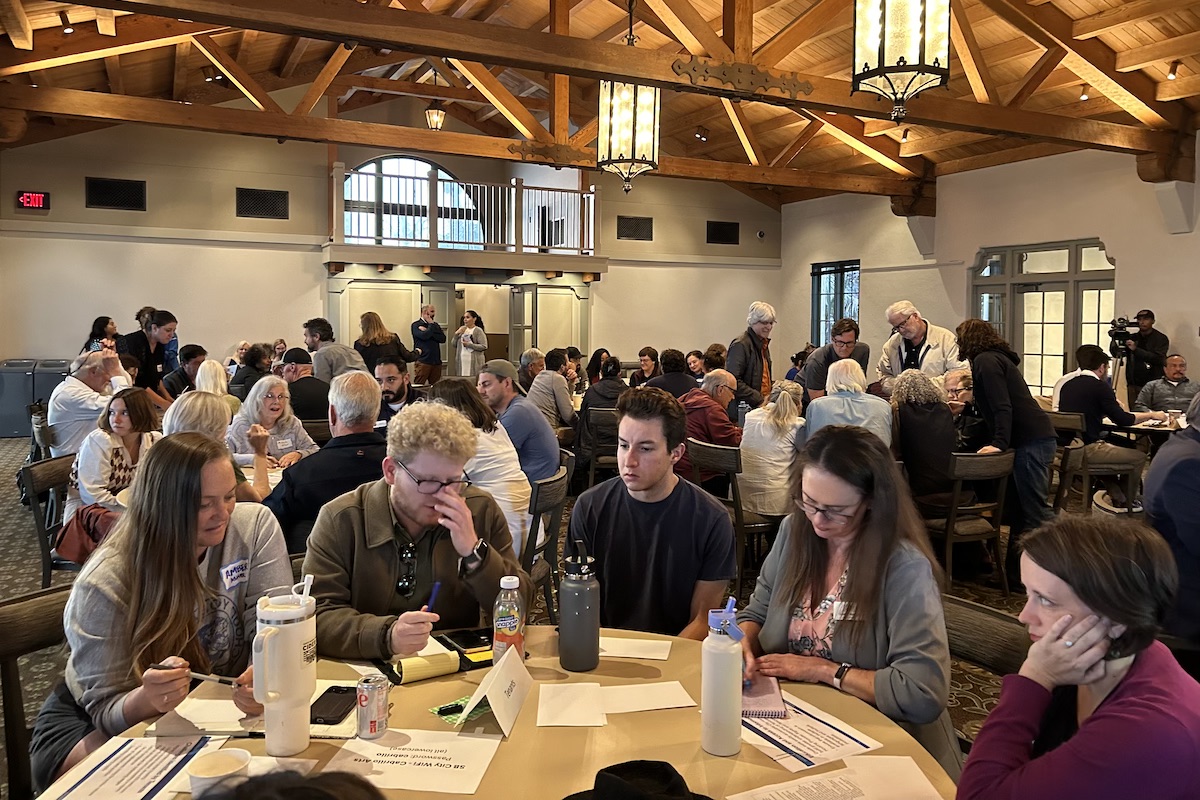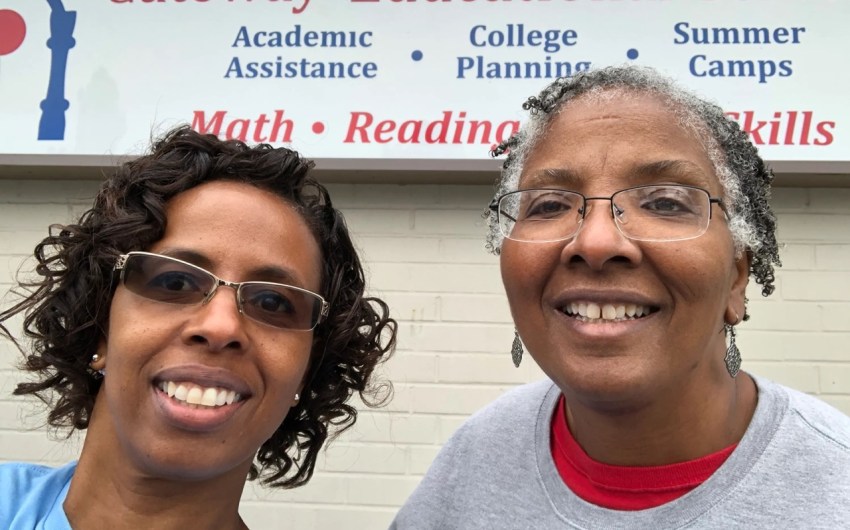Community Packs House to Offer Solutions to Santa Barbara’s Housing Crisis
City Hosts Workshop with Tenants, Landlords, Developers, and More at Cabrillo Pavilion

Santa Barbara’s housing crisis bleeds into every section of the community, and on Monday, the city hosted a public workshop in an attempt to get everybody together at the Cabrillo Pavilion — tenants, landlords, activists, developers (both private and nonprofit), and homeowners — to voice their concerns and try to come together toward a solution.
And while they weren’t exactly at the same table — tenants sat with other tenants, and landlords huddled together in another section — it offered the city’s Housing Crisis Task Force a chance to gauge public opinion on some of the proposed fixes, such as a rental registry, rent stabilization, and programs to make building affordable housing much quicker and easier for developers.
With more than 50 people in the room, around a dozen city staff on hand to facilitate small group discussions, and another 50 participants online on Zoom, there were plenty of opinions on the ideal approach to addressing the crisis. But with the average one-bedroom apartment in Santa Barbara going for $2,750, and the average two-bedroom going for $4,074 (according to the most recent city survey of rents), there was one thing that almost all residents agreed on: Santa Barbara is not affordable at almost any income level.
“We are not in a crisis; this is an emergency, and somebody needs to pull the fire alarm,” said one tenant, Mark Zimmer.
The housing crisis task force — formally known as the Santa Barbara City Council Housing Crisis Ad Hoc Committee — provided the numbers behind the housing crunch, and reported what the committee had learned after meeting with dozens of stakeholders from every side of the housing industry. The committee’s recommendations ranged from increasing housing supply to improving regulations, and the workshop was intended to allow each small group to make a list of top-priority solutions.
Each group had specific concerns. Nonprofit developers wanted the city to leverage public-private partnerships and make building affordable housing much easier and faster. Community-based organizations said that preserving housing stock was crucial, and that programs like a right-to-return with a cap on increases should be implemented to ensure people can stay in their homes. Tenants and advocates were loud and clear about their support for rent stabilization, which they consider as an integral part of a housing package, along with a rental registry and a permanent right-to-counsel program.
Landlords, who rebranded their group table as “housing providers,” were concerned over the prospect of more regulations, and worried that rent stabilization — which they refer to as rent control — would cause a spike in rents in the long term, even if it did keep rents low in the short term. They preferred that the city focus on incentivizing developers, and look for ways to crack down on out-of-town corporate landlords instead of creating sweeping laws that could hurt small-scale “mom-and-pop” landlords.
The topic of a rental registry and rent stabilization came across several times during public comment, as well. Rachel Sim, a member of the Santa Barbara Tenants Union, said that a rental registry — a citywide database of rental properties that helps keep track of compliance — would be “a great way to ensure all actors are playing fairly and playing by the rules,” and could go a long way toward easing the tensions between landlords and tenants.
Property owner Loy Beardsmore warned that even talking about rent control can drive rent prices up, “making things worse for tenants and raising rental criteria.” Other property owners argued that well-known economists have documented problems with rent control in other cities.
Housing Authority Executive Director Rob Fredericks weighed in, saying in his comments that rent stabilization may have risks in the long term, but it “might just be what the city needs” to keep rents affordable in the short term.
The committee members themselves were split, with councilmembers Oscar Gutierrez and Kristen Sneddon both in support of rent stabilization as part of the solution, while councilmember Alejandra Gutierrez said that she was still not convinced.
“It’s not a secret. I have my reservations about rent stabilization,” she said. “There is a crisis, but we can’t be reactive to the crisis; we really have to think long-term.”
Councilmember Sneddon, on the other hand, said she felt that the city has had plenty of chances to hear from the community and now it was time to take action.
“I feel that we have stalled,” Sneddon said. “Over half of our households are rent-burdened or extremely rent-burdened. Our own city workers can’t afford to stay in the city that they serve.”
Sneddon said that she supported rent stabilization two years ago when the council voted it down 4-3, and that she would be ready to move forward with both rent stabilization and a rental registry should the city bring it across the council again. “I believe the time is now,” she said.
While no action was taken at the community workshop, the City Council will hear a report on the findings and discuss possible solutions on November 12.
Premier Events
Thu, Nov 28
12:00 PM
Santa Barbara
Thanksgiving Dinner at The Harbor Restaurant
Fri, Nov 22
11:00 AM
Santa Barbara
Santa Barbara Antique & Vintage Show & Sale
Fri, Nov 22
6:00 PM
Santa Barbara
Introduction to Crochet Workshop
Fri, Nov 22
7:30 PM
Carpinteria
Rod Stewart VS. Rolling Stones Tribute Show
Fri, Nov 22
9:00 PM
Santa Barbara
Numbskull Presents: Jakob’s Castle
Sat, Nov 23
11:00 AM
Santa Barbara
Santa Barbara Antique & Vintage Show & Sale
Sat, Nov 23
12:00 PM
Santa Barbara
Fall 2024 Healing Arts Faire
Sat, Nov 23
7:30 PM
Santa Barbara
SBCC Theatre Arts Department presents “Mrs. Bob Cratchit’s Wild Christmas Binge”
Sun, Nov 24
11:00 AM
Santa Barbara
Santa Barbara Antique & Vintage Show & Sale
Sun, Nov 24
6:00 PM
Santa Barbara
¡Viva el Arte de Santa Bárbara! Mariachi Garibaldi de Jaime Cuellar
Sun, Dec 01
5:00 PM
Santa Barbara
Paseo Nuevo Tree Lighting Ceremony
Thu, Nov 28 12:00 PM
Santa Barbara
Thanksgiving Dinner at The Harbor Restaurant
Fri, Nov 22 11:00 AM
Santa Barbara
Santa Barbara Antique & Vintage Show & Sale
Fri, Nov 22 6:00 PM
Santa Barbara
Introduction to Crochet Workshop
Fri, Nov 22 7:30 PM
Carpinteria
Rod Stewart VS. Rolling Stones Tribute Show
Fri, Nov 22 9:00 PM
Santa Barbara
Numbskull Presents: Jakob’s Castle
Sat, Nov 23 11:00 AM
Santa Barbara
Santa Barbara Antique & Vintage Show & Sale
Sat, Nov 23 12:00 PM
Santa Barbara
Fall 2024 Healing Arts Faire
Sat, Nov 23 7:30 PM
Santa Barbara
SBCC Theatre Arts Department presents “Mrs. Bob Cratchit’s Wild Christmas Binge”
Sun, Nov 24 11:00 AM
Santa Barbara
Santa Barbara Antique & Vintage Show & Sale
Sun, Nov 24 6:00 PM
Santa Barbara
¡Viva el Arte de Santa Bárbara! Mariachi Garibaldi de Jaime Cuellar
Sun, Dec 01 5:00 PM
Santa Barbara





















